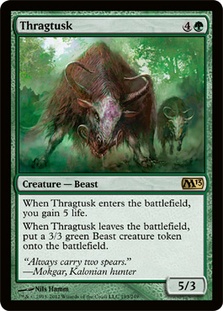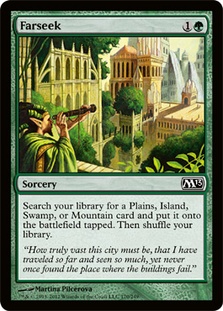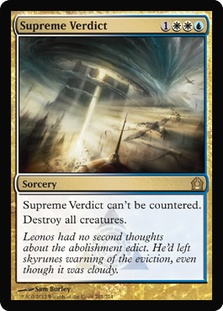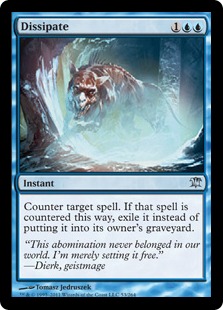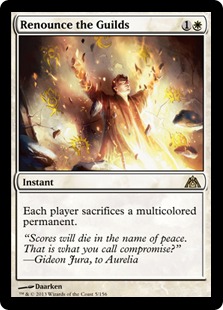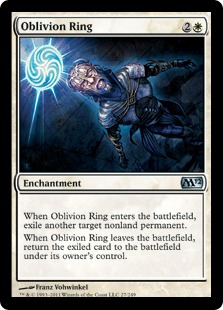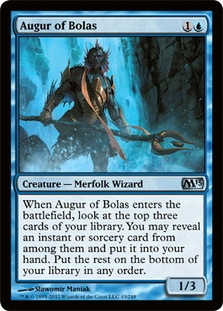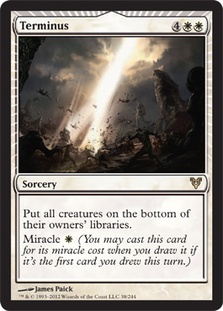Sometimes great decks just get lost in the shuffle. Bant Control was a dominant strategy in Standard right from the printing of Return to Ravnica. It featured so many of the format’s most powerful cards, like Thragtusk, Farseek, Sphinx’s Revelation, Supreme Verdict, all rolled into an air-tight shell with a focused game plan and no clear weakness. So what happened?
For a combination of reasons, Bant fell out of the limelight. In part it was a backlash against Sphinx’s Revelation decks; the format became saturated with Slaughter Games, Jace, Memory Adepts, and aggro decks that were resilient to Supreme Verdict. In part it was similar decks, like Prime Speaker Bant and Esper Control, stealing players that might otherwise have stuck to classic Bant Control. In part it was simply the lack of an outspoken champion willing to carry the Bant flag. Whatever the reason, though, it broke my heart to see such a fun, interesting, and powerful strategy relegated to the pages of the history books. It’s time to bring it back!
Before I offer my decklist, which I played at the StarCityGames.com Open in Baltimore last weekend, I’d like to offer two decks that came before and inspired the version I’m currently recommending.
Creatures (7)
Planeswalkers (2)
Lands (24)
Spells (27)

The original Bant Control deck was built by Andrew Cuneo, Sam Black, and me, with the help of a number of other talented players. It took me to back-to-back Grand Prix top 8s early in the Standard season before the release of Gatecrash. The keys to this deck were patience and confidence; all we had to do to win was to realize that nothing your opponents could do really threatened you. We could sit behind an Alchemist’s Refuge and defend ourselves from creatures with Thragtusk and Supreme Verdict and defend ourselves from everything else with permission, planeswalkers, and Elixir of Immortality. We would make land drops, Sphinx’s Revelation over and over again, and win the game at our convenience with Nephalia Drownyard. Truly a masterpiece!
Creatures (13)
Planeswalkers (4)
Lands (18)
Spells (25)
- 3 Forest
- 1 Plains
- 4 Island
- 2 Syncopate
- 1 Azorius Charm
- 4 Supreme Verdict
- 3 Detention Sphere
- 3 Sphinx's Revelation
- 1 Selesnya Keyrune
- 1 Urban Evolution
- 2 Plasm Capture
Sideboard

For Pro Tour Dragon’s Maze, Brad Nelson and the rest of #TeamSCG again turned to Bant Control. The card pool was different, but the principles were the same. We used the combination of excellent defensive creatures and removal spells to reach a point in the game where the opponent simply could no longer compete with the power of our end-game cards.
In this case, though, it was not the slow and painful torture of Nephalia Drownyard that ended the opponent’s life. With this deck, when the time was right, we would grant a quick and merciful death with the brutally efficient and utterly unstoppable Aetherling.
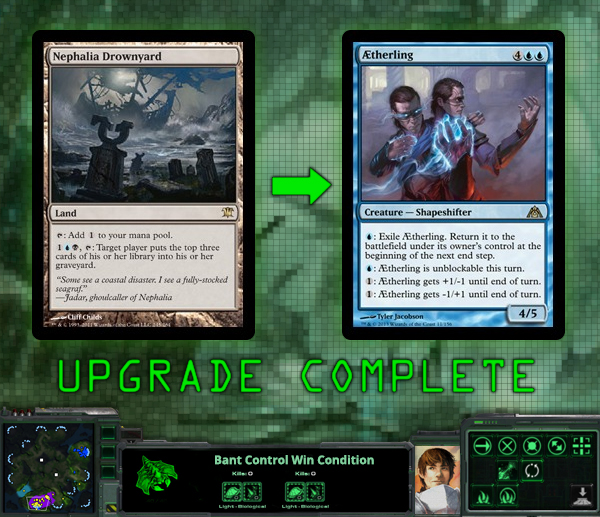
Inspired by the above decks, this is what I played at the StarCityGames.com Standard Open in Baltimore.
Creatures (7)
Lands (23)
Spells (30)

I would be remiss to discuss Standard without mentioning Jund, which is a similarly beloved strategy that has brought me a lot of success.
Please, my friends, unless you’re playing a hyper-aggressive deck, don’t leave home without four Farseeks and four Thragtusks! These are the best cards for any green midrange or control deck, and the only ones that I never consider touching in sideboarding with Jund. To me, playing a slow W/U/R, Esper, or W/R/B deck seems supremely masochistic. Why not make things easy on yourself? Thragtusk is simultaneously the best card against most beatdown decks and the best way to answer an opposing Thragtusk. It is the best card in Standard, and at such an easy mana cost in a format with such good mana why not just play it?
Playing Defense
The presence of Thragtusk is what makes Bant such a difficult strategy to attack. In a way, the card is really at its most powerful in a control deck alongside Supreme Verdict. From the opponent’s perspective, it’s truly impossible to play around both of these cards at once. You play out your hand and try your best to have a dominant board presence by the time Thragtusk comes down, but then you get cleaned up by Supreme Verdict. On the other hand, you can try to hold back and let one or two creatures do their work but then a Thragtusk threatens to come down, gains you five life, trades in combat one turn, and chump block another, easily buying three or more turns. Because Bant is a deck that gets so much more powerful with each passing turn, this too is a losing proposition.
So from the perspective of the opponent, the presence of both Thragtusk and Supreme Verdict creates a frustrating challenge. From the perspective of the Bant player, though, things couldn’t be easier! The beauty of Thragtusk is that it’s so expendable. One of my favorite moves with this deck is to Verdict away my own Thragtusk (along with three or four of my opponent’s creatures, of course). If it’s gained me five life, held off an attack, and forced the opponent to commit extra creatures, then the Beast has already done its job. This is not even to mention that the token it makes will leave me with a decided advantage on the board after the dust settles!
Winning the Game
With Bant, the name of the game is patience. Making land drops, drawing cards, and preserving your life total is what’s really important. Winning the game is often an afterthought. This is why the old version of Bant Control didn’t devote any maindeck slots to true win conditions, instead taking the slow route via Nephalia Drownyard and Elixir of Immortality.
With the printing of Aetherling, though, that strategy ought to change. Like a wolf (or perhaps a rabbit?) that smells blood, the temptation to go for the kill is just too strong for me now that Aetherling exists.
What I look for in a win condition is reliability. I never liked Prime Speaker Bant because I don’t feel as though cards like Loxodon Smiter or Restoration Angel really have a place in a Bant Control deck, at least not in large numbers. To try to win the game with these cards in a world full of Thragtusks, removal, and board sweepers you need to have so many copies in your deck that you’re almost playing a different game. In the old days I sometimes used the approach of Cavern of Souls plus Sigarda, Host of Herons, since she couldn’t easily be countered, killed, or blocked. This way, a mere two copies was enough to reliably win the game if used carefully. Aetherling is better across the board, and has the added advantage of dodging both friendly and hostile Supreme Verdicts.
This new win condition improves the deck for a number of reasons. First, relieving time pressures. Anyone who’s played control in the last two years will know that it takes a long time to beat somebody with a single copy of Nephalia Drownyard if they choose to play things out to the bitter end. Aetherling though, when you’re ready to do so, will end the game in three turns almost invariably.
Second, cutting Nephalia Drownyard improves the manabase since it means fewer colorless lands, and no need for black sources of mana.
Finally, having an “escape route” is a quality I very much value in a deck. What I mean by “escape route” is, in essence, a plan for what to do when things are not going well. In the case of Bant Control, it’s to kill them with Aetherling!
Planeswalker ticking towards their ultimate and I’m out of Oblivion Rings? I’ll play Aetherling!
Nephalia Drownyard putting a clock on me that I can’t slow down? I’ll play Aetherling!
Everything I said in the introduction of this article is true, that Bant is a lost strategy which I feel should have been seeing more play all along. I’ll confess, though, that the thing which really sparked my interest in it was the printing of Aetherling, and especially the way it combines with Cavern of Souls. Before Dragon’s Maze, I felt strongly that the Jund colors offered everything we really wanted or needed for a slow Thragtusk deck. Now there’s Aetherling, which is the ultimate creature for a midrange strategy. While I still love Jund and have lots of faith in it, I’m now willing to concede that there’s a reason to at least consider other color combinations.
Mana Advantage
Alongside Thragtusk and Aetherling, I’ve cited Farseek as one of Standard’s strongest cards and a real reason to play Bant. This Standard format is home to more insanely powerful four, five, and six mana spells than anything I can remember. Frequently, games degenerate into a contest of who can play the most powerful spell or, if you’re playing the same cards, who can play more of them. The way to win these fights is to get ahead on mana. In addition to tons of card drawing, Bant Control plays thirty mana sources, and has Farseek to accelerate. This is its biggest advantage over W/U/R, W/R/B, and Esper.
Frequently, the best way to fight an Aetherling in a blue mirror is to play your own Aetherling. When these battles come up, the Bant player has the clear advantage, as he or she is more likely to play the first Aetherling and likely to have more mana to devote each turn. One more point worth mentioning is that the Bant player is likely to have more life as well thanks to the presence of Thragtusk.
The Decklist
Sphinx’s Revelation: The purpose of this card should be straightforward. In fact, if anything, it’s the presence of only three copies that ought to draw question. Sphinx’s Revelation is a key to the strong late game of Bant Control. However, in the original version of the deck your goal was to cast a Revelation and draw into another Revelation, chaining them together and burying the opponent under pure card advantage. Now, though, you want to cast a Revelation and draw into an Aetherling. There comes a point in the game where you’re ready to start spending all of your mana on Aetherling each turn, so the fourth Revelation is no longer completely necessary.
Dissipate and Plasm Capture: Standard’s aggressive decks are fast and brutal, and preclude control players from overloading on maindeck permission. However, a small number of hard counters are key to Bant Control working properly and being able to lock up the game when the time comes. Dissipate is the industry standard, and does its job exactly as it needs to be done. Plasm Capture just serves as a little extra spice, and is more difficult to play around when it’s present in lower numbers.
Renounce the Guilds: With no instant speed black removal, Sire of Insanity poses a big problem. Thankfully, Renounce the Guilds serves as an instant speed answer to Sire that’s simply a great card in Standard right now. It’s one extra early defensive play against aggressive red decks, it kills many of Jund’s big threats, and answers problem cards like Domri Rade and Geist of Saint Traft.
Oblivion Ring: Unfortunately, playing Renounce the Guilds means there’s no place for multicolor cards in this deck, and that means no Detention Sphere. However, Oblivion Ring is not much worse, and serves a crucial role by taking out Voice of Resurgence (making Renounce more effective—great teamwork!) as well as planeswalkers and other creatures that refuse to die to Supreme Verdict.
Augur of Bolas: Augur is a great defensive play, and helps ensure that the deck runs smoothly. I wouldn’t mind playing as many as three Augur of Bolas, and as many as two Restoration Angels to go along with them. However, it’s important to find the proper balance of creatures versus instants and sorceries to make the deck run smoothly. Remember that each additional copy of Augur you add makes the existing Augurs worse, since it cuts into your spell count and increases the chances of awkward draws. I’d want to be in the ballpark of twenty-four spells before I’d consider playing three Augurs, but perhaps changing some things around could make that an appropriate way to build the deck.
A Brief Tournament Report
I went 3-2 in Baltimore before dropping to rush home for a non-Magic commitment (normally I hate to drop from tournaments). I beat Jund, Zombies, and Naya Blitz, and lost twice to red splash green aggro decks.
In fact, the only games I lost were against the red decks, and they were extremely close where some different decisions or card choices had the potential to change the outcome in my favor. I do think that aggressive red decks are a good matchup for Bant, as Supreme Verdict and Thragtusk remain two of the most powerful cards against them. Plus, this build of Bant has more early defensive plays than ever before in the form of Azorius Charm, Renounce the Guilds, and Oblivion Ring.
Humorously enough, I showed up to the tournament with seventy-four cards set in stone, and was deciding whether to make my last sideboard card a third Terminus or a singleton Centaur Healer. I settled on Terminus and promptly lost twice to decks where Centaur Healer would have been at its best.
Looking back, I don’t think the third copy of Terminus is necessary. If the popularity of Junk Reanimator declines I could also see trimming the number of maindeck Ground Seals to one or zero, perhaps freeing up more slots for Augur of Bolas. Elderscale Wurm still needs some more testing, but with so much red-green and Naya these days, I like the idea of it a lot.
The tournament gave me a lot of hope for Bant in the future, and I’m going to continue trying to improve on a decklist, which I already think is equally competitive with any of the established decks in standard. I hope you enjoyed reading about this new take on an old strategy, and I hope you’ll give it a try for yourself!

